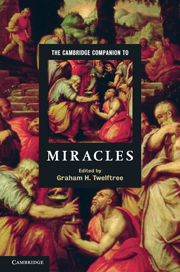Book contents
- Frontmatter
- Introduction
- Part I Fundamental issues
- Part II Miracles in antiquity and the Middle Ages
- 3 Miracles in the Hebrew Bible
- 4 Miracles in the Greek and Roman world
- 5 Miracles in Second Temple and early rabbinic Judaism
- 6 The miracles of Jesus
- 7 Miracles in early Christianity
- 8 Miracles In The Middle Ages
- Part III Miracles and major religions
- Part IV Miracle today
- Index
5 - Miracles in Second Temple and early rabbinic Judaism
from Part II - Miracles in antiquity and the Middle Ages
Published online by Cambridge University Press: 28 May 2011
- Frontmatter
- Introduction
- Part I Fundamental issues
- Part II Miracles in antiquity and the Middle Ages
- 3 Miracles in the Hebrew Bible
- 4 Miracles in the Greek and Roman world
- 5 Miracles in Second Temple and early rabbinic Judaism
- 6 The miracles of Jesus
- 7 Miracles in early Christianity
- 8 Miracles In The Middle Ages
- Part III Miracles and major religions
- Part IV Miracle today
- Index
Summary
The time period covered in this chapter encompasses two distinct epochs in Jewish history: the time before the destruction of the temple in 70 ce characterized by diversity, instability and sectarianism, and the time after the destruction of the temple characterized by the rise of rabbinic Judaism, the eventual disappearance of rival sectarian groups, the cessation of sacrificial worship, and the shift of emphasis towards the synagogue and the Torah. In addition, ‘from about the middle of the third century bceall Judaism must really be designated “Hellenistic Judaism” in the strict sense’, as Martin Hengel repeatedly emphasized. At the same time, however, the differences between Jewish and Hellenistic worldviews and the various degrees of Hellenization of Palestinian and diaspora Judaism should not be overlooked. In some cases, Graeco-Roman concepts provide primary categories for presenting Jewish beliefs and practices. In other instances, the Hellenistic world view is deliberately rejected. This encounter between different cultures has also had an impact on the understanding of miracles in Jewish literature. In some cases, miracles are perceived through the lenses of the Hellenistic surroundings, while in other cases they serve as the means of legitimization of a specifically Jewish perception of reality.
Jewish authors typically present miracles and miracle workers in dialogue with their sacred texts. They all believed that Scripture embodied the will of God and that interpretation of the sacred writings provided for its application to contemporary circumstances. In this process, they engaged in two related types of activities: they reinterpreted traditional biblical accounts about the miracles from Israel’s history and used the scriptural framework to interpret the miraculous events from their own time.
- Type
- Chapter
- Information
- The Cambridge Companion to Miracles , pp. 95 - 112Publisher: Cambridge University PressPrint publication year: 2011
- 2
- Cited by



